-
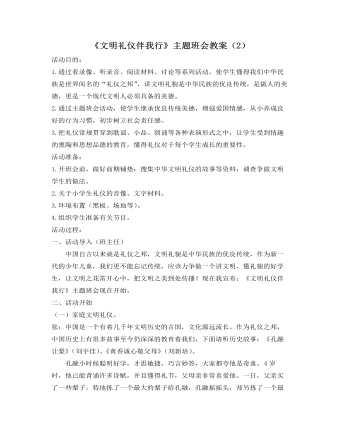
《文明礼仪伴我行》主题班会教案(2)
(二)校园文明礼仪张:中国是一个有着几千年文明历史的古国,文化源远流长“礼学”是中国文化的重要组成部分。在中国,自古以来,讲究做人要懂得礼貌谦让,因此中国被称为“文章华国,诗礼传家”,被称为“文明礼仪之邦”。张:中国古代的礼仪规范不断发展改革形成了我们的现代文明礼仪,在校园这个既庄严又活泼、既紧张又文明的环境中,我们少先队员不仅要学好文化知识,还要自觉加强道德修养,讲礼貌,懂礼仪,做一个文明少年。礼仪举止包含了许多内容,你知道那些校园礼仪吗?谁愿意说给大家听?学生自由发言。尹:规范的校园礼仪是怎样的呢?下面请欣赏(岳炀)表演的几种最基本的礼仪形式。表演校园礼仪:正确的走姿、正确的站姿、正确的坐姿、交往礼仪、课堂礼仪、课间礼仪、递物与接物。
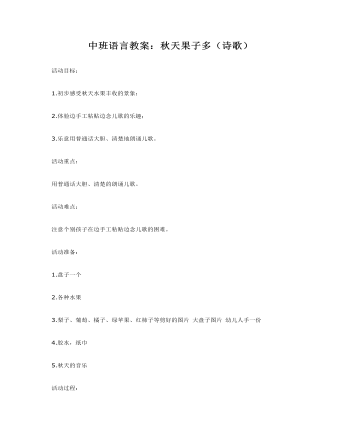
中班语言教案:秋天果子多(诗歌)
2.体验边手工粘贴边念儿歌的乐趣;3.乐意用普通话大胆、清楚地朗诵儿歌。活动重点:用普通话大胆、清楚的朗诵儿歌。活动难点:注意个别孩子在边手工粘贴边念儿歌的困难。活动准备:1.盘子一个2.各种水果
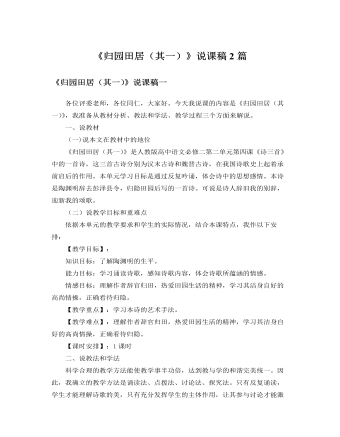
人教版高中语文必修2《归园田居(其一)》说课稿2篇
我还运用多媒体投影幻灯片给学生设置两组相互对照的选项,让同学们根据幻灯片选择:你赞同每组中那一种价值取向?一组是功名、进取、高官、厚禄与自然、隐逸、本性、自由。另一组是科学、发展、强大、集中与诗意、和谐、柔弱、个体。经过合作探究,讨论解答,学生结合陶渊明的归隐对第一组讨论探究的应该比较容易,而对第二组的理解探究会出现一定的难度,教师可以就学生的情感价值观方面适当的给予点拨引导:幻灯片上面的第二组文字通过对比,给我们提供了两种价值取向,你是要通过科学、发展、强大和集中来实现遨游太空等童话,那就势必会令我们放弃了诗意的童话,只关注工业的发展,城市面积的扩大,乡村田园必将减少 。你还是要维护生态平衡,保护一切的多样性呢?我认为诗意永远要领导科学,梅罗和陶渊明就共同表达了八个字——诗意、和谐、柔弱和个体。你的本性在田园,当我们身心疲惫时,我们都需要一个心灵的家园,所以我希望大家无论做何选择都能够守住我们那片宁静、祥和的心灵家园。
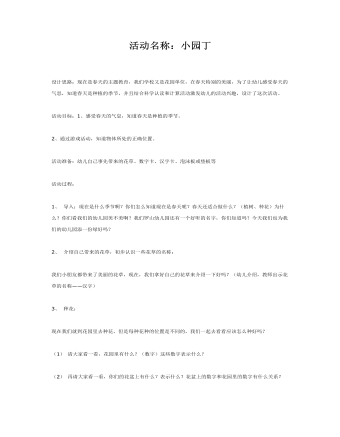
中班主题课件教案:春天主题小园丁
活动目标:1、感受春天的气息,知道春天是种植的季节。2、通过游戏活动,知道物体所处的正确位置。活动准备:幼儿自己事先带来的花草、数字卡、汉字卡、泡沫板或垫板等活动过程:1、 导入:现在是什么季节啊?你们怎么知道现在是春天呢?春天还适合做什么?(植树、种花)为什么?你们看我们的幼儿园美不美啊?我们罗山幼儿园还有一个好听的名字,你们知道吗?今天我们也为我们的幼儿园添一份绿好吗?2、 介绍自己带来的花草,初步认识一些花草的名称:我们小朋友都带来了美丽的花草,现在,我们拿好自己的花草来介绍一下好吗?(幼儿介绍,教师出示花草的名称——汉字)
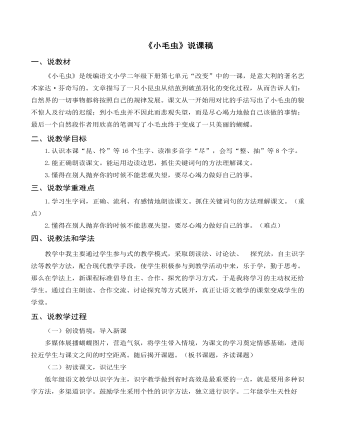
(说课稿)《 小毛虫》部编人教版二年级上册语文
二、说教学目标1.认识本课“昆、怜”等16个生字、读准多音字“尽”,会写“整、抽”等8个字。 2.能正确朗读课文。能运用边读边思,抓住关键词句的方法理解课文。3.懂得在别人抛弃你的时候不能悲观失望,要尽心竭力做好自己的事。三、说教学重难点1.学习生字词,正确、流利、有感情地朗读课文。抓住关键词句的方法理解课文。(重点)2.懂得在别人抛弃你的时候不能悲观失望,要尽心竭力做好自己的事。(难点)四、说教法和学法教学中我主要通过学生参与式的教学模式,采取朗读法、讨论法、?探究法,自主识字法等教学方法,配合现代教学手段,使学生积极参与到教学活动中来,乐于学,勤于思考。那么在学法上,新课程标准倡导自主、合作、探究的学习方式,于是我将学习的主动权还给学生。通过自主朗读、合作交流、讨论探究等方式展开,真正让语文教学的课堂变成学生的学堂。
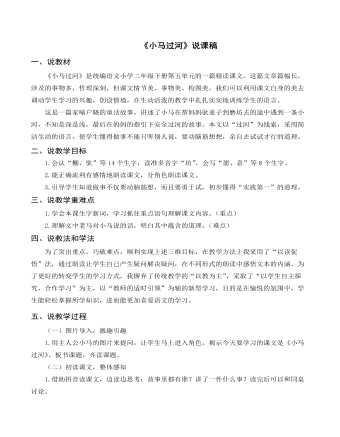
(说课稿)《小马过河》部编人教版二年级上册语文
一、说教材《小马过河》是统编语文小学二年级下册第五单元的一篇精读课文。这篇文章篇幅长,涉及的事物多,哲理深刻。但课文情节美、事物美、构图美,我们可以利用课文自身的美去调动学生学习的兴趣,创设情境,在生动活泼的教学中扎扎实实地训练学生的语言。这是一篇家喻户晓的童话故事。讲述了小马在帮妈妈驮麦子到磨坊去的途中遇到一条小河,不知是深是浅,最后在妈妈的指引下安全过河的故事。本文以“过河”为线索,采用简洁生动的语言,使学生懂得做事不能只听别人说,要动脑筋想想,亲自去试试才行的道理。二、说教学目标1.会认“棚、驮”等14个生字,读准多音字“坊”,会写“愿、意”等8个生字。 2.能正确流利有感情地朗读课文,分角色朗读课文。3.引导学生知道做事不仅要动脑筋想,而且要勇于试,初步懂得“实践第一”的道理。三、说教学重难点1.学会本课生字新词,学习抓住重点语句理解课文内容。(重点) 2.理解文中老马对小马说的话,明白其中蕴含的道理。(难点)
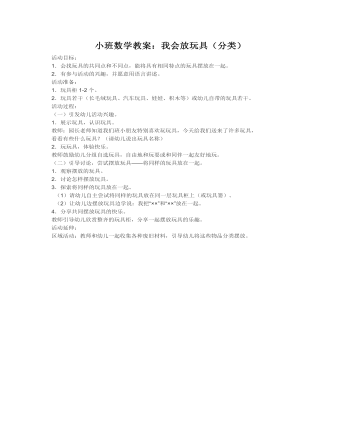
小班数学教案:我会放玩具(分类)
2.有参与活动的兴趣,并愿意用语言讲述。 活动准备: 1.玩具柜1-2个。 2.玩具若干(长毛绒玩具、汽车玩具、娃娃、积木等)或幼儿自带的玩具若干。 活动过程: (一)引发幼儿活动兴趣。 1.展示玩具,认识玩具。 教师:园长老师知道我们班小朋友特别喜欢玩玩具,今天给我们送来了许多玩具, 看看有些什么玩具?(请幼儿说出玩具名称) 2.玩玩具,体验快乐。 教师鼓励幼儿分组自选玩具,自由地和玩耍或和同伴一起友好地玩。
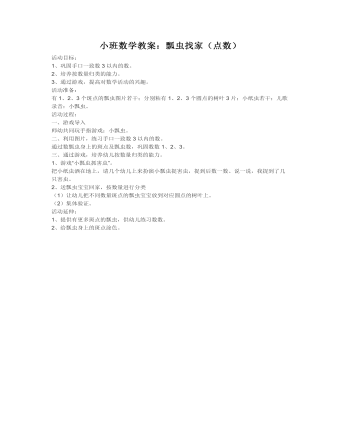
小班数学教案:瓢虫找家(点数)
2、培养按数量归类的能力。 3、通过游戏,提高对数学活动的兴趣。 活动准备: 有1、2、3个斑点的瓢虫图片若干;分别粘有1、2、3个圆点的树叶3片;小纸虫若干;儿歌录音:小瓢虫。 活动过程: 一、游戏导入 师幼共同玩手指游戏:小瓢虫。 二、利用图片,练习手口一致数3以内的数。 通过数瓢虫身上的斑点及瓢虫数,巩固数数1、2、3。
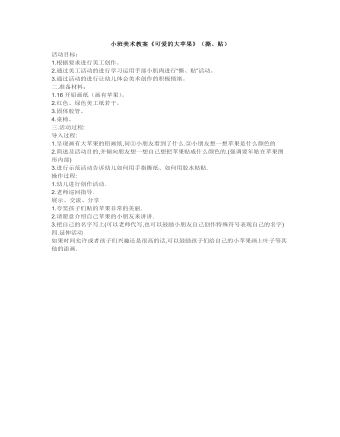
小班美术教案《可爱的大苹果》(撕、贴)
2.通过美工活动的进行学习运用手部小肌肉进行“撕、贴”活动。 3.通过活动的进行让幼儿体会美术创作的积极情绪。 二.准备材料: 1.16开铅画纸(画有苹果)。 2.红色、绿色美工纸若干。 3.固体胶管。 4.桌椅。 三.活动过程: 导入过程: 1.呈现画有大苹果的铅画纸,问①小朋友看到了什么.②小朋友想一想苹果是什么颜色的 2.简述及活动目的,并倾向朋友想一想自己想把苹果贴成什么颜色的.(强调要年贴在苹果图形内部)
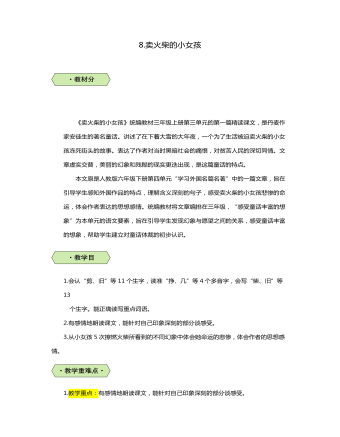
三年级语文卖火柴的小女孩教案
《卖火柴的小女孩》统编教材三年级上册第三单元的第一篇精读课文,是丹麦作家安徒生的著名童话。讲述了在下着大雪的大年夜,一个为了生活被迫卖火柴的小女孩冻死街头的故事。表达了作者对当时黑暗社会的痛恨,对贫苦人民的深切同情。文章虚实交替,美丽的幻象和残酷的现实更迭出现,是这篇童话的特点。本文原是人教版六年级下册第四单元“学习外国名篇名著”中的一篇文章,旨在引导学生感知外国作品的特点,理解含义深刻的句子,感受卖火柴的小女孩悲惨的命运,体会作者表达的思想感情。统编教材将文章编排在三年级,“感受童话丰富的想象”为本单元的语文要素,旨在引导学生发现幻象与愿望之间的关系,感受童话丰富的想象,帮助学生建立对童话体裁的初步认识。
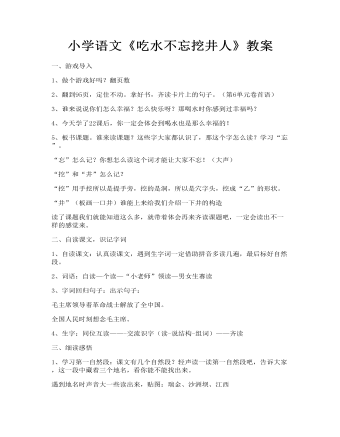
小学语文《吃水不忘挖井人》教案
4、今天学了22课后,你一定会体会到喝水也是那么幸福的!5、板书课题。谁来读课题?这些字大家都认识了,那这个字怎么读?学习“忘”。“忘”怎么记?你想怎么读这个词才能让大家不忘!(大声)“挖”和“井”怎么记?“挖”用手挖所以是提手旁,挖的是洞,所以是穴字头,挖成“乙”的形状。“井”(板画一口井)谁能上来给我们介绍一下井的构造读了课题我们就能知道这么多,就带着体会再来齐读课题吧,一定会读出不一样的感觉来。
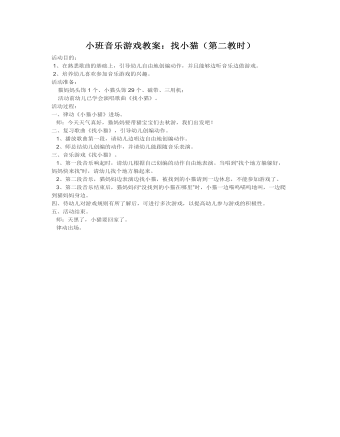
小班音乐游戏教案:找小猫(第二教时)
2、培养幼儿喜欢参加音乐游戏的兴趣。 活动准备: 猫妈妈头饰1个、小猫头饰29个、磁带、三用机; 活动前幼儿已学会演唱歌曲《找小猫》。 活动过程: 一、律动《小猫小猫》进场。 师:今天天气真好,猫妈妈要带猫宝宝们去秋游,我们出发吧! 二、复习歌曲《找小猫》,引导幼儿创编动作。 1、播放歌曲第一段,请幼儿边唱边自由地创编动作。 2、师总结幼儿创编的动作,并请幼儿能跟随音乐表演。

新人教版高中英语必修3Unit 1 Festivals and Celebrations教学设计二
1. Ss look at the picture and scan the passage to understand the main idea while teacher is giving the following questions to inspire Ss to think.*Where are those people?*What are they doing?*Why are they so excited?2. Ss complete the passage with the appropriate -ing form. Then discuss and check the answers with class.Answers: boring, interesting, taking, exciting, amazing3. The teacher raises questions for the students to discuss and encourages them to express their opinions.*Do you like La Tomatina? Why or why not?4. Each group representative reports the discussion result, the teacher gives feedback and the evaluation.Step 6 PracticeActivity 41. Ss complete the Ex 2 in Using structures.2. Check the answers after finishing the exercises.①The dragon boat races are the most exciting part of the Dragon Boat Festival.② The children were excited to go Easter egg hunting.③What an amazing performance! This is the best music festival I have ever been to.④We were amazed by her funny-looking hat.⑤His inspiring speech at the conference won the admiration/ favour of the audience.⑥This is a challenging game to test your memory and observation capabilities. 3. T asks Ss to finish Ex 3 and 4 in Using structures by themselves, then check the answers with class.Step 6 Homework1. Understand and master the functions and usage of the -ing form;2. Finish the other exercises in Using structures.1、通过本节内容学习,学生是否理解和掌握动词-ing形式作定语和表语的功能和意义;2、通过本节内容学习,学生能否在理解文段内容的基础上,根据上下文语境和表达逻辑,能正确运用动词-ing形式描述节日庆典。3、通过本节内容学习,学生是否归纳和积累用于表达情绪的相关词汇。

新人教版高中英语必修3Unit 1 Festivals and Celebrations教学设计一
本板块的活动主题是“谈论节日活动”(Talk about festival activities),主要是从贴近学生日常生活的角度来切入“节日”主题。学生会听到发生在三个国家不同节日场景下的简短对话,对话中的人们正在参与或将要亲历不同的庆祝活动。随着全球化的进程加速,国际交流日益频繁,无论是国人走出国门还是外国友人访问中国,都已成为司空见惯的事情。因此,该板块所选取的三个典型节日场景都是属于跨文化交际语境,不仅每组对话中的人物来自不同的文化背景,对话者的身份和关系也不尽相同。1. Master the new words related to holiday: the lantern, Carnival, costume, dress(sb)up, march, congratulation, congratulate, riddle, ceremony, samba, make - up, after all. 2. To understand the origin of major world festivals and the activities held to celebrate them and the significance of these activities;3. Improve listening comprehension and oral expression of the topic by listening and talking about traditional festivals around the world;4. Improve my understanding of the topic by watching pictures and videos about different traditional festivals around the world;5. Review the common assimilation phenomenon in English phonetics, can distinguish the assimilated phonemes in the natural language flow, and consciously use the assimilation skill in oral expression. Importance:1. Guide students to pay attention to the attitude of the speaker in the process of listening, and identify the relationship between the characters;2. Inspire students to use topic words to describe the festival activities based on their background knowledge. Difficulties:In the process of listening to the correct understanding of the speaker's attitude, accurately identify the relationship between the characters.

新人教版高中英语必修3Unit 2 Morals and Virtues教学设计二
Activity 41. Students complete the task of activity 4, then teachers and students check the answers. 2. The teacher organized the students to work together and asked them to use the tables and mind maps sorted out before to retold the important choices in Lin Qiaozhi's life and their resultsStep 5 Language points1. The teacher asks the students to read the text carefully, find out the core words and long and difficult sentences in the text and draw lines, understand the use of vocabulary, and analyze the structure of long and difficult sentences. 2. The teacher explains and summarizes the usage of core vocabulary and asks the students to take notes. 3. The teacher analyzes and explains the long and difficult sentences that the students don't understand, so that the students can understand them better. Step 6 Homework1. Read the text again, in-depth understanding of the text; 2. Master the use of core vocabulary and understand the long and difficult sentences. 3. Complete relevant exercises in the guide plan. 1、通过本节内容学习,学生是否理解和掌握阅读文本中的新词汇的意义与用法;2、通过本节内容学习,学生能否结合文本特点总结林巧稚的人生原则和人格品质特征;3、通过本节内容学习,学生能否针对人生抉择发表自己的看法;能否全面地、客观地、理性地看待问题,进而对道德和人性有更加深入的思考和理解。

新人教版高中英语必修3Unit 1 Festivals and Celebrations教学设计三
*wide range of origins(= a great number of different origins, many kinds of origins)*It featured a parade and a great feast with music, dancing, and sports. (=A parade and a great feast with music, dancing, and sports were included as important parts of the Egyptian harvest festival.)*.. some traditions may fade away and others may be established.(= Some traditions may disappear gradually, while other new traditions may come into being.)Step 6 Practice(1) Listen and follow the tape.The teacher may remind the students to pay attention to the meaning and usage of the black words in the context, so as to prepare for the completion of the blanks in activity 5 and vocabulary exercises in the exercise book.(2) Students complete the text of activity 5 by themselves.The teacher needs to remind the students to fill in the blanks with the correct form of the vocabulary they have learned in the text.Students exchange their answers with their partners, and then teachers and students check their answers.(3)Finish the Ex in Activity 5 of students’ book.Step 7 Homework1. Read the text again, in-depth understanding of the text;2. Discuss the origin of festivals, the historical changes of related customs, the influence of commercial society on festivals and the connotation and essential meaning of festivals.3. Complete relevant exercises in the guide plan.1、通过本节内容学习,学生是否理解和掌握阅读文本中的新词汇的意义与用法;2、通过本节内容学习,学生能否结合文本特点快速而准确地找到主题句;3、通过本节内容学习,学生能否理清论说文的语篇结构和文本逻辑,了解节日风俗发展与变迁,感悟节日的内涵与意义。

新人教版高中英语必修3Unit 2 Morals and Virtues教学设计三
The joke set her crying.这个玩笑使她哭起来。Step 5 ReadingActivity 31. Students read the small text in activity 3. The teacher provides several small questions to check whether students understand the content of the text and the ideographic function of the -ing form in the text.*Where are those people?*Why did Dr Bethune come to China?*How did he help the Chinese people during the war?*What did Chairman Mao Zedong say about him?2. Ss try to rewrite some sentences using the -ing form. Then check the answers. When checking the answers, the teacher can ask different students to read the rewritten sentences and give comments.Answers:1. he became very interested in medicine, deciding to become a doctor.2. …after hearing that many people were dying in the war.3. Helping to organise hospitals, he taught doctors and nurses, and showed people how to give first aid./ He helped to organise hospitals, teaching doctors and nurses, and showing people how to give first aid.4. …praising Dr Bethune as a hero to be remembered in China.Step 6 PracticeActivity 4Students complete grammar activities 2 and 3 on page 69 of the workbook.Step 6 Homework1. Understand and master the functions and usage of the -ing form;2. Finish the other exercises in Using structures.1、通过本节内容学习,学生是否理解和掌握动词-ing形式作宾语补足语语和状语语的功能和意义;2、通过本节内容学习,学生能否正确使用动词-ing形式描述人物的行为、动作及其经历;3、通过本节内容学习,学生能否独立完成练习册和导学案中的相关练习。

新人教版高中英语必修3Unit 2 Morals and Virtues教学设计四
3.Teachers ask different groups to report the answers to the questions and ask them to try different sentence patterns.The teacher added some sentence patterns for students to refer to when writing.Step 4 Writing taskActivity 51.Write the first draft.Students first review the evaluation criteria in activity 5, and then independently complete the draft according to the outline of activity 4, the answers to the questions listed in the group discussion and report, and the reference sentence pattern.2.Change partners.The teacher guides the students to evaluate their partner's composition according to the checklist of activity 5 and proposes Suggestions for modification.3.Finalize the draft.Based on the peer evaluation, students revise their own compositions and determine the final draft.Finally, through group recommendation, the teacher selects excellent compositions for projection display or reading aloud in class, and gives comments and Suggestions.Step 5 Showing writingActivity 5T call some Ss to share their writing.Step 6 Homework1. Read the passage in this section to better understand the passage.2. Carefully understand the hierarchical structure of the article, and deeply understand the plot of the story according to the causes, process and results;3. Independently complete the relevant exercises in the guide plan.1、通过本节内容学习,学生是否理解和掌握阅读文本中的新词汇的意义与用法;2、通过本节内容学习,学生能否通过人物言行的对比分析道德故事的深层内涵;3、通过本节内容学习,学生能否根据故事的起因、经过和结果来深入理解故事的情节,从而了解文章的层次结构;4、结合现实生活案例发表自己的见解和看法,写一篇观点明确、层次分明的故事评论。

新人教版高中英语必修3Unit 2 Morals and virtues教学设计一
(2) students are divided into groups according to the requirements of activity 3. Each student shares a story of personal experience or hearing-witnessing kindness, and then selects the most touching story in the group and shares it with the whole class. Before the students share the story, the teacher can instruct them to use the words and sentence patterns in the box to express. For example, the words in the box can be classified:Time order: first of all, then, after that, later, finally logical relationship :so, however, although, butTeachers can also appropriately add some transitional language to enrich students' expression:Afterwards, afterwards, at last, in the end, eventuallySpatial order: next to, far from, on the left, in front ofOtherwise, nevertheless, as a result, therefore, furthermore, in addition, as well asSummary: in a word, in short, on the whole, to sum up, in briefStep 8 Homework1. Understand the definition of "moral dilemma" and establish a correct moral view;2. Accumulate vocabulary about attitudes and emotions in listening texts and use them to express your own views;3. Complete relevant exercises in the guide plan.1、通过本节内容学习,学生能否理解理解“道德困境”的定义;2、通过本节内容学习,学生能否通过说话人所表达的内容、说话的语气、语调等来判断其态度和情绪;3、通过本节内容学习,学生能否针对具体的道德困境发表自己的看法和见解,能否掌握听力理训练中的听力策略。

新人教版高中英语必修3Unit 3 Diverse Cultures教学设计三
The price is the same as(the price was)before the war.价格与战前相同。(4)定语从句中的“关系代词+助动词be”可以省略。The ticket(that/which was)booked by his sister has been sent to him.他妹妹订的那张票已送到了他那里。Step 5 PracticeActivity 3(1) Guide students to complete the four activities in the Using Structures part of exercise book, in which activities 1 and 2 focus on ellipsis in dialogue answers, activity 3 focus on signs and headlines, two typical situations where ellipsis is used, and activity 4 focus on ellipsis in diary, an informal style.(2) Combine the examples in the above activities, ask students to summarize the omitted situations in groups, and make their own summary into a poster, and post it on the class wall after class to share with the class.(This step should give full play to the subjectivity of students, and teachers should encourage students to conclude different ellipsis phenomena according to their own understanding, they can conclude according to the different parts omitted in the sentence.)Step 6 Homework1. Understand and master the usages of ellipsis;2. Finish the other exercises in Using structures of Workbook.1、通过本节内容学习,学生是否理解和掌握省略的用法;2、通过本节内容学习,学生能否根据上下文语境或情景恢复句子中省略的成分,体会使用省略的效果;3、通过本节内容学习,学生能否独立完成练习册和导学案中的相关练习。

